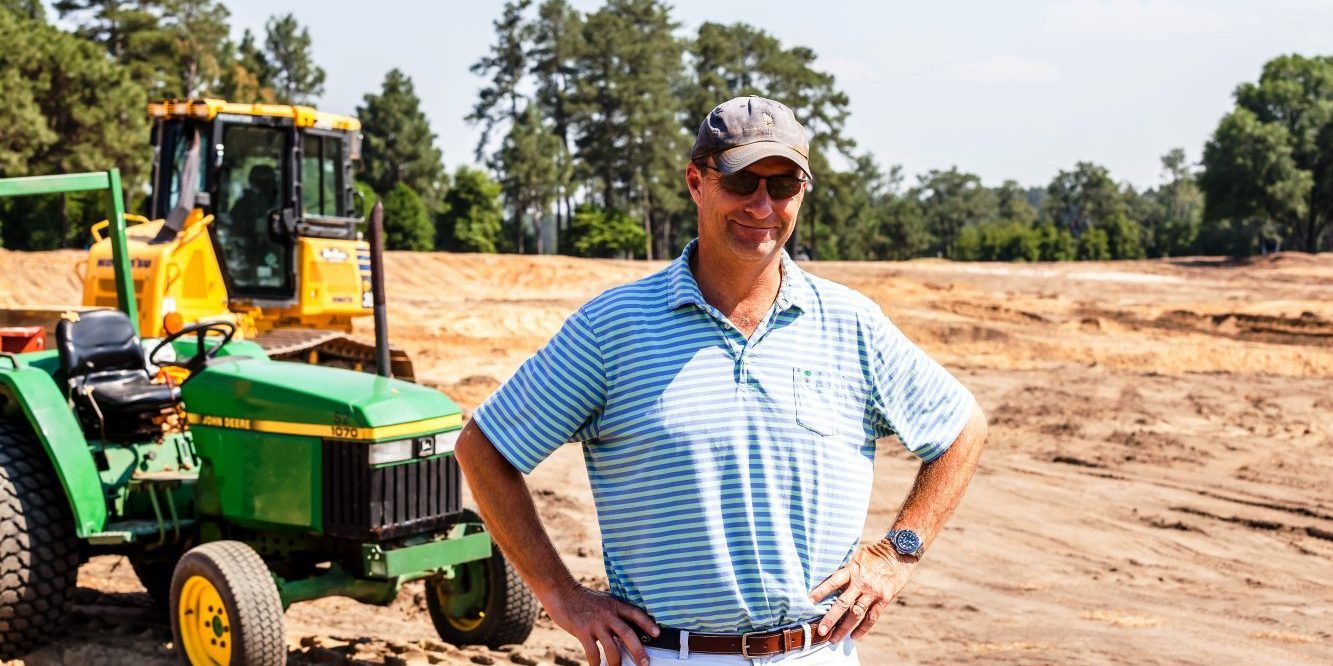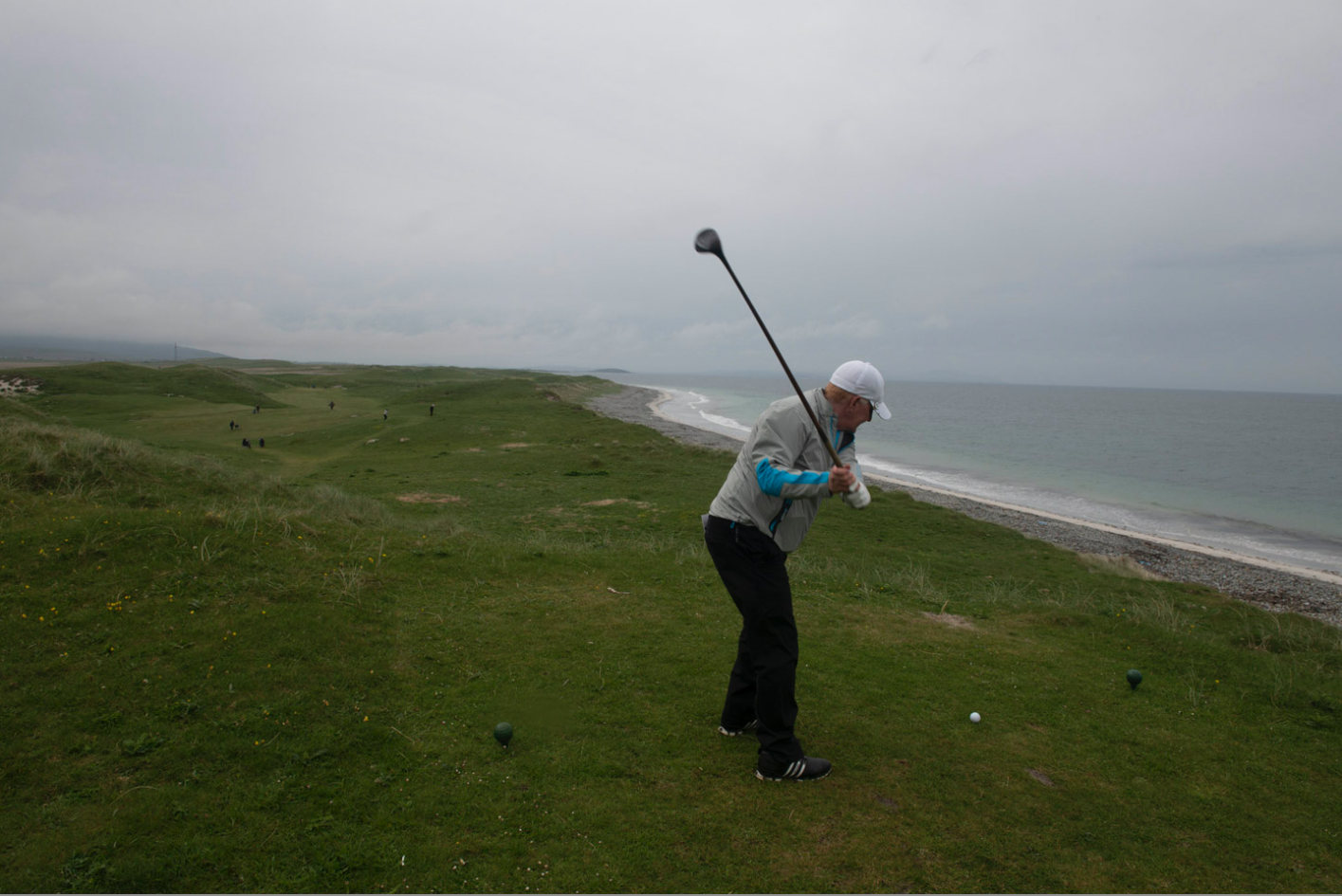Inside the Architect’s Mind – Gil Hanse
by Crai S. Bower
 I love natural golf architecture.
I love natural golf architecture.
A few years ago, I played Askernish Golf Club (aka the “Lost Course”) on the remote Isle of South Uist in the Outer Hebrides of Scotland. Nothing, and I mean nothing, had changed since Old Tom Morris etched the layout at the landowners’ request in 1891.
The village let the course go fallow for several decades before making it playable again, i.e., mowing some fairways, tee boxes and tamping down the greens a bit. That’s it.
It wouldn’t seem odd at Askernish were you to crank a shepherd’s crook to hit an oval-shaped rock around a set of oceanfront mounds.
Much as I’d like to go deep describing the dead crows and rabbits that lay prone on the ground with alarming regularity and the wayfinding forays on even the straightest holes, that is for another time.
But here’s the connection. Askernish plays so naturally upon the landscape, it feels like a Gil Hanse-restored course (minus the carrion, of course).
“The original architect’s work, philosophy and style informs all decision-making when you restore a course,” Hanse says.
Hanse, who graduated from Cornell with a bachelor’s degree in history, revels in restoration projects, an opportunity to expand his interest in course design history, a passion he shares with fellow natural architects Tom Doak, Ben Crenshaw, and Bill Coore.
“You can never say the word ‘typically’ when restoring these courses because each carries unique characteristics,” Hanse says. “If we say we are going to do a blanket Tillinghast design, we are just being lazy. You have to get to the bottom of the design.”

The architect and his team at Hanse Golf Design have gotten to the “bottom of the design” of several of the most famous 18s in America, including The Country Club at Brookline, Winged Foot Golf Club, Southern Hills and Oakland Hills. They’ve restored more than one dozen Donald Ross layouts alone. Restoring a Ross or Tillinghast masterpiece is the golf equivalent of taking a scalpel to a da Vinci or van Gogh.
“Who on earth would ever alter a Donald Ross layout?!” is a logical question. The short answer is the members. Consider the Eisenhower Tree on the 17th hole at Augusta National. Frustrated by the tree’s magnetic effect on his drives, the 34th Commander in Chief unsuccessfully lobbied the membership to have the loblolly pine removed. (In February 2014, the tree was removed after suffering extensive damage from a major ice storm.)
Members everywhere have tried to “Be like Ike,” often with more success, influencing greenkeepers to shorten a pesky par 4, shallow-out deep bunkers and, yes, remove an obtrusive tree or two.
Natural growth is the other element of change. Trees grow daily, green structures often shrink and bunkers, mini-sand dunes, shift. When considering a renovation, Hanse seeks a dossier equivalent to a graduate student’s stack of primary research documents to remedy the alterations.
“We start with historical photographs,” he says. “When we restored Los Angeles Country Club’s North Course, we collaborated with Geoff Shackelford, who wrote the book on George C. Thomas Jr., the original architect. Usually, over time a club makes a series of minor changes, but here they moved holes two and six dramatically to suit the wishes of certain members.”
Hanse says the bunkers were no longer consistent with Thomas. “We often see the same evolution at historic courses. Trees get planted, bunkers get moved and greens often get smaller as one renovation rolls into another.”
Of course, current members are not always happy with a complete restoration. Several Oakmont Country Club members filed lawsuits to try and halt the removal of more than 12,600 trees. Most of the trees, which crowded fairways and greens over time, were planted in the 1960s in an attempt to bring architect Henry Clay Fownes’ links-style design “up to date.” Though not involved in the original removal, Hanse consults with Oakmont today to restore the course to its 1903 Master Plan.

“What do all the great courses have in common?” asks Hanse, who learned to love golf from his grandfather. “They reward thoughtful study and play. People want to play them over and over again.”
With his design partner Jim Wagner, Hanse also revels in the responsibility to create new layouts that people will want to play “again and again.” His design firm recently completed the Fields Ranch East course as the signature course of the PGA’s new headquarters, Omni Frisco PGA Resort. America’s first golf entertainment complex, complete with The Dance Floor, a 2-acre putting course, and The Swing, a Hanse-designed lighted 10-hole short course, the resort is already slated to host 26 PGA events over the next 12 years.
Like all Hanse projects, sustainable design was top of mind in Frisco. The East course features recirculated water, native plantings, and new wetlands.
“The wetlands we’ve created turned out to be one of the nicest features of the entire property,” Hanse says. “Going into it, I was worried that they would appear engineered and not support native vegetation and wildlife, but they have done so beautifully. They’re also designed to hold flood water that can rise from 18 inches to four feet. I would challenge anybody to say they are not natural.”
Frisco PGA Resort demonstrates that Hanse doesn’t only collect reams of information for restoration projects. The design team hired a local botanist who brought a palette of 30 different native plants annotated with characteristics like density, height and water needs.
“It’s all about the original architect, like Tillinghast or Ross, when we restore a course,” says Hanse. “But this (PGA Resort) is our baby.”
Hanse hadn’t even heard of landscape architecture until a Cornell classmate told him about the class he was taking. Until then he thought he might work in a parks and recreation department. He considers his golf course holes similar to designing a play structure in a public park.
“We want to make a fun and interesting course for everybody,” he says. “But we want to ensure it will also be a worthy choice for a major championship. With the pros, you’re always fearful they might misinterpret a hole and jump to conclusions, especially before they’ve figured out how to play it. It’s a nerve-racking process, but we take great pride in what we do.”
Ivy-league educated, insightful and profoundly talented, it’s no surprise the Hanse Golf Design website contains a page entitled “Our Philosophy,” which features this statement:
“Nature is a complex system subject to human influences and interpretation. We look to nature for inspiration, but have confidence that our golf courses are not merely a replication of nature but a work of art clearly reflecting human influence.”
Who could argue with that?
Crai Bower writes scores of adventure travel articles a year for over 25 publications, including golf stories for American Way, Hearst Media and Journey magazine. He appears regularly on the American Forces Network as a travel commentator. Visit his site at FlowingStreamMedia.net.





